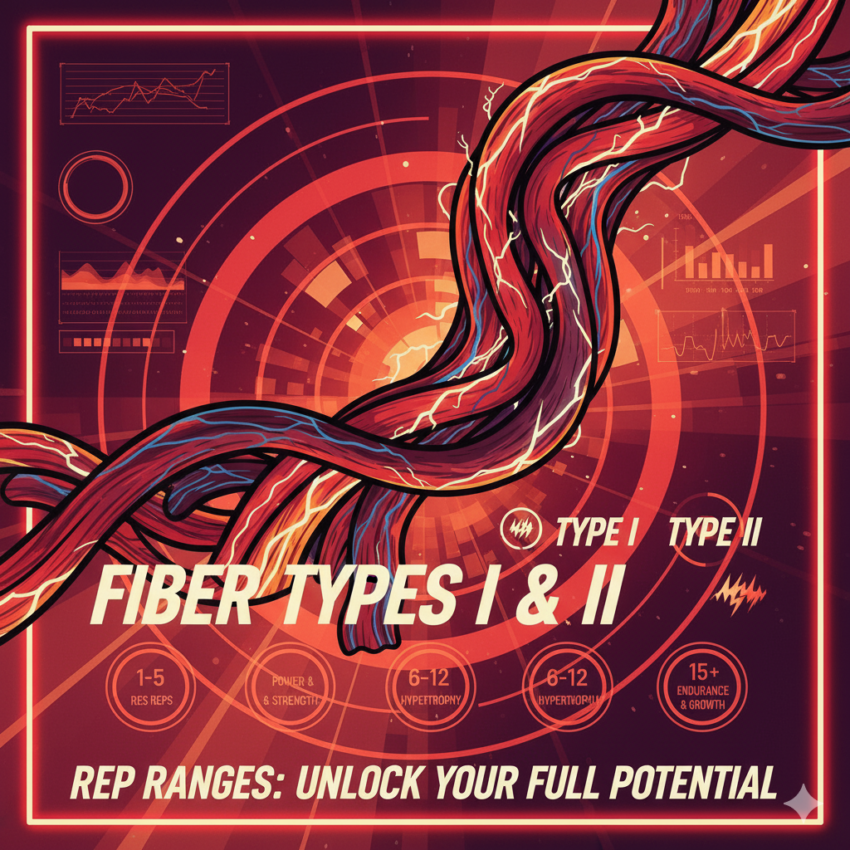Maximizing Hypertrophy: Training for Both Fast and Slow-Twitch Muscle Fibers
To achieve maximal muscle gains, a well-rounded approach that addresses the unique characteristics and growth potential of both fast-twitch (Type II) and slow-twitch (Type I) muscle fibers is essential. While genetics play a role in your innate fiber composition, strategic training can optimize the growth of both types.
The Roles and Subtypes of Muscle Fibers
Skeletal muscle fibers are broadly classified into two main types, with fast-twitch fibers further divided into subtypes:
| Property | Type I (Slow-Twitch) | Type IIA (Fast-Twitch Oxidative-Glycolytic) | Type IIX (Fast-Twitch Glycolytic) |
| Contraction Speed | Slow | Fast | Fastest |
| Fatigue Resistance | High | Medium-High | Low |
| Primary Energy System | Aerobic (Oxidative) | Both Aerobic and Anaerobic | Anaerobic (Glycolytic) |
| Force Production | Low | High | Highest |
| Hypertrophy Potential | Low-Moderate | High | Highest |
- Type I (Slow-Twitch) Fibers: These fibers are endurance-oriented due to their rich capillary supply and high mitochondrial density, making them very resistant to fatigue. They are the first to be recruited for low-intensity, long-duration activities.
- Predominant in Sports: Marathon running, cycling, long-distance swimming, and postural muscles.
- Type IIA (Fast-Twitch) Fibers: These fibers represent a hybrid, capable of both oxidative and glycolytic metabolism. They contract quickly, produce significant force, and have a good resistance to fatigue, making them crucial for sustained high-power output.
- Predominant in Sports: Middle-distance running (800m), team sports (soccer, basketball), and strength-endurance events.
- Type IIX (Fast-Twitch) Fibers: These are the most powerful and explosive fibers, utilizing anaerobic metabolism. They fatigue very quickly but generate the largest force and fastest contractions. They are essential for maximal strength and speed.
- Predominant in Sports: Sprinting (100m), powerlifting, Olympic weightlifting, and jumping.
Training and Rep Ranges for Fiber Growth
For maximizing overall muscle hypertrophy, current data suggests that training sets taken to or very close to muscular failure can produce similar overall muscle growth across a wide range of rep schemes (e.g., 6 to 35 reps), regardless of the specific fiber type. This is largely explained by the size principle of motor unit recruitment.
The Size Principle states that as the demand for force increases, motor units are recruited sequentially: first the smaller, fatigue-resistant Type I units, then the larger, more powerful Type IIA units, and finally, the largest, most explosive Type IIX units.
Targeting Each Fiber Type for Maximal Gains:
While heavy resistance training recruits all fiber types, varying your rep ranges is still an effective strategy to provide a diverse stimulus and ensure all fibers are thoroughly taxed:
- High-Force/Low Reps (1-5 Reps): Uses heavy loads (85%+ of 1RM).
- Primary Benefit: Directly recruits the Type IIX fibers from the first rep due to the high initial force demand. Excellent for maximal strength and power, which is foundational for hypertrophy. Moderate Force/Moderate Reps (6-12 Reps): Uses moderate loads (60-85% of 1RM).
- Primary Benefit: The traditional “hypertrophy zone.” This range allows for sufficient mechanical tension to recruit Type IIA and Type IIX fibers, and enough metabolic stress to stimulate significant growth.
- Low Force/High Reps (15+ Reps): Uses lighter loads (under 60% of 1RM).
- Primary Benefit: To reach failure in this range, the Type I fibers are heavily fatigued first, forcing the delayed recruitment of Type IIA and IIX fibers as the set progresses. This method is effective for maximizing Type I fiber growth and inducing high metabolic stress.
Conclusion on Rep Ranges: Implement a variety of rep ranges over your training cycle (e.g., monthly or quarterly) to maximize both mechanical tension (heavier weights) and metabolic stress (higher reps) across your entire fiber profile.
Muscle Fiber Distribution by Muscle Group
Muscle fiber composition varies significantly between different muscles, reflecting their primary function (postural endurance vs. explosive movement). While individual variation exists, here are some typical percentages of Type I (Slow-Twitch) fibers for common muscle groups in humans:
| Muscle Group | Typical % Type I Fibers (Approximate) | Dominant Fiber Type | Primary Function |
| Soleus (Calf) | 80% | Type I (Slow-Twitch) | Posture, walking endurance |
| Quadriceps | 50-55% | Mixed | General movement, stability |
| Hamstrings | 50% | Mixed | Knee flexion, hip extension |
| Gastrocnemius (Calf) | 50% | Mixed/Type II (Fast-Twitch) | Explosive ankle plantarflexion (jumping, sprinting) |
| Triceps Brachii | 30-40% | Type II (Fast-Twitch) | Explosive elbow extension |
| Biceps Brachii | 40-50% | Mixed | Elbow flexion |
| Pectoralis Major | 40-55% | Mixed | Chest pressing and adduction |
Muscles that are highly involved in posture (like the Soleus and deep back muscles) tend to be heavily Type I dominant for sustained activity. Muscles used for explosive, quick movements (like the Triceps and sometimes the Gastrocnemius) tend to be more Type II dominant.
Key Takeaway for Hypertrophy
To maximize muscle gains, your training plan should be diverse, incorporating a periodized mix of:
- Heavy Training (1-5 reps): To stimulate Type IIX fibers and increase maximal strength.
- Moderate Training (6-12 reps): To maximize overall tension and volume on Type IIA and IIX fibers.
- Lighter Training (15+ reps): To fully fatigue and grow Type I fibers and induce high metabolic stress.
Focusing on progressive overload across these rep ranges ensures you are providing the optimal stimulus for growth across all muscle fiber types, leading to comprehensive and maximal hypertrophy.
